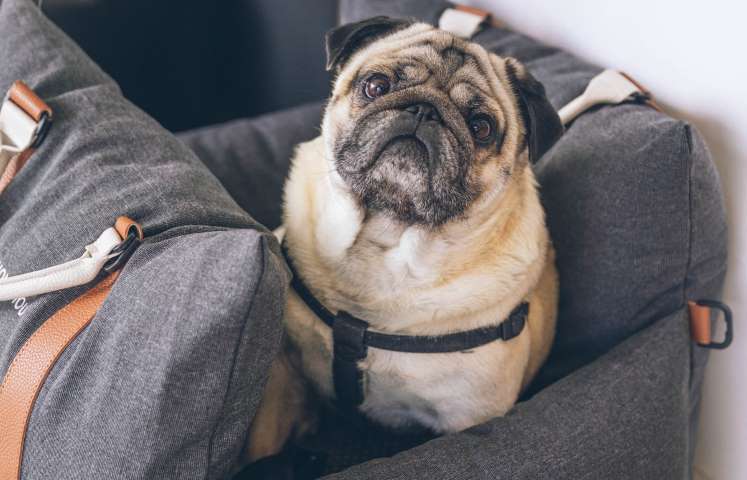
Are you planning to move abroad but heartbroken by the idea of leaving your beloved fur baby behind? Or maybe you’re just the sort of adventurous pet owner who loves the idea of traveling with a four-legged companion by your side?
If you want or need to travel internationally with your dog for any reason, you’ll be happy to know that most healthy, non-senior dogs are able to make the journey overseas safely. You should be aware, however, that international travel with a pet in tow takes a bit of careful research and planning to pull off successfully.
Researching the ins and outs of flying to another country with your pet may seem overwhelming, especially if this is your first time doing so, but don’t fear. This handy guide will ensure that your overseas trip is smooth sailing for both you and your pup:
Choose a Good Carrier for International Travel
Whether your furry friend flies in your plane’s cargo hold, in the cabin with you, or with a pet shipping company, you’ll need a robust carrier or kennel to keep them safe during the journey. Sizing your pet’s travel carrier appropriately with respect to their size and weight is especially important for ensuring that they stay comfortable throughout the flight. As a general rule, your dog should be able to stand up inside their carrier with a 2-inch clearance above their head.
Just as luggage can get knocked around and dinged during a flight, so too can your pet’s travel carrier. If your dog will be traveling in cargo, you’ll want a carrier with a solid, strong body, and a leakproof bottom that will hold up against the occasional stresses of air travel. Metal fasteners for the door are preferable so that your carrier doesn’t fall open mid-flight.
If your pet is traveling in the cabin with you, on the other hand, a soft-sided carrier will probably work best. These are more pliable and tend to fit better under airplane seats.
Make Sure Your Pet Has a Blanket, Food, and Water
While it’s not a good idea to pack your pet’s carrier with too many unnecessary things like toys, you may want to include a blanket to keep them cozy and warm during travel. Canine cuddlers dog blankets, old baby blankets, or any other type of blanket your pet already sleeps with are all solid choices. Blankets that carry the scent of home are bound to be especially comforting for them.
In addition to a blanket, you should also provide your pet with enough food and water to get through the trip. If your dog won’t be in the cabin with you during your flight, place their food in a clear ziplock bag and tape this to the side of their carrier so that crew members can readily access it. You can do the same with frozen water inside one of your dog’s drinking bowls—simply place it in a ziplock and attach it to the inside of the kennel. Lastly, include an empty bowl for airline staff members to fill with fresh water when possible.
Research Your Airline and Your Destination
Reading up on airline pet policies, researching regulations at your destination, and gathering the required paperwork are likely to be the most complicated part of traveling internationally with your pet. Most of these rules and regulations are in place to prevent the spread of rabies, especially in rabies-free countries.
If you’re traveling to a place that is rabies-free from the United States, which is currently classed as a rabies-controlled territory, you may have to brace yourself for some extra time at customs to get the required clearance. You may also be required to quarantine your pet for as long as a few months before you fly. Wherever you’re headed, checking pet entry requirements at your destination is a must.
When it comes to booking flights, meanwhile, choosing direct flights or flights with the lowest possible number of connections to your destination are best to minimize pet stress. Do also consider departure and arrival times that are comfortable for your pet and avoid traveling at the hottest times of the day.
Different airlines will have different guidelines for pets traveling internationally. Call your airline to find out their specific policies on what pet sizes and breeds they allow to travel with them, as well as any other in-flight regulations you’ll have to abide by. You may also be able to find this information on your chosen airline’s website.
Consult Your Veterinarian
Your vet is the best person to talk to when it comes to preparing your pup for international travel. They’ll be able to administer any additional vaccinations or treatments that your destination country might require. If your vet is USDA-accredited, they’ll also be able to issue the health certificates and other documents verifying that your pet is fit to travel. And if they don’t have USDA accreditation, they’ll probably at least be able to refer you to someone who is.
International travel can be stressful for both pets and their humans, but it doesn’t have to be. As long as you plan ahead and do your research thoroughly, you and your dog can look forward to the adventure of a lifetime.